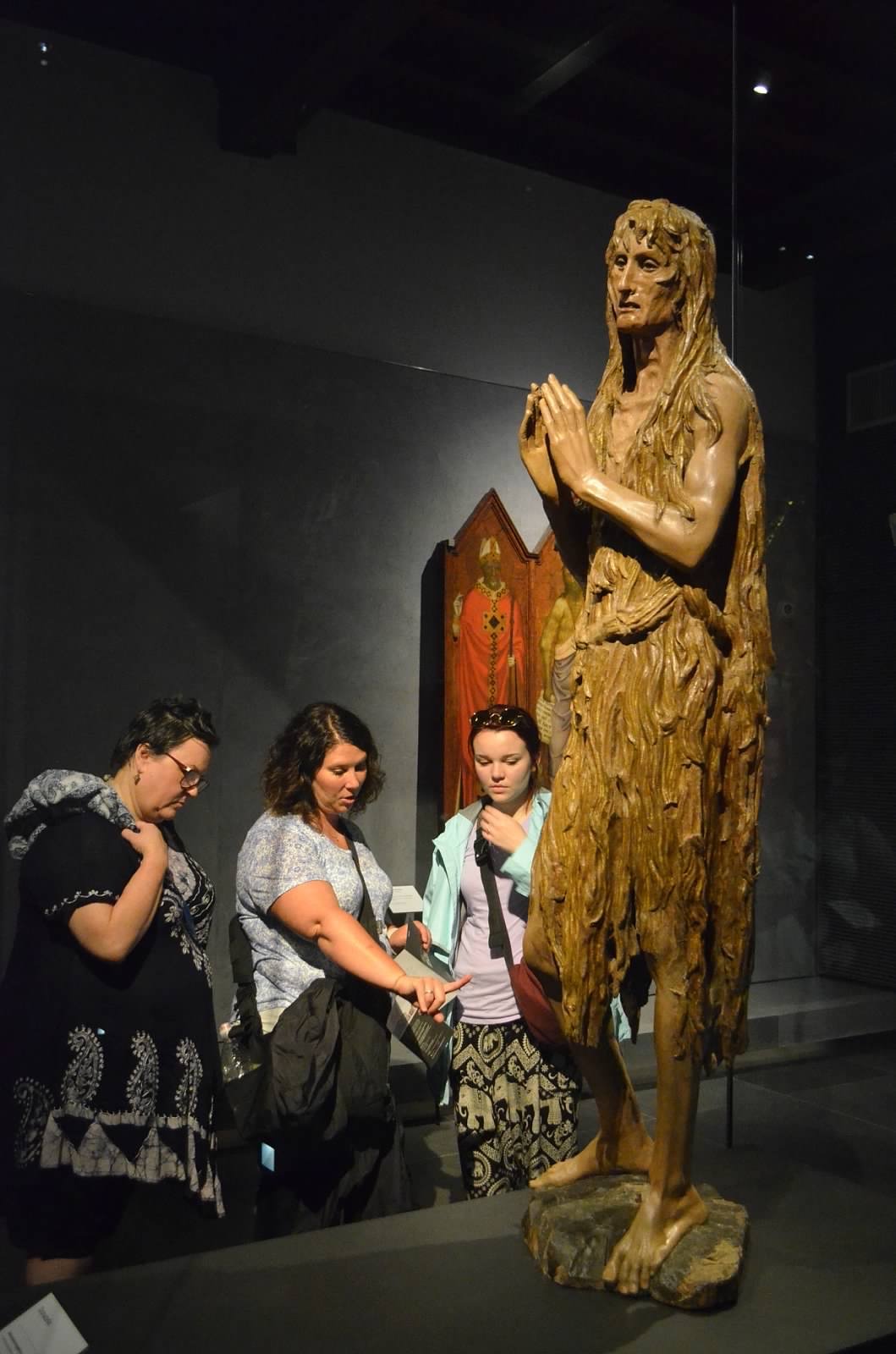The Power of Art
Guest Article By: Andrea McGuirt - Board Member
I teach art history at a large public high school in Tennessee. Recently I asked my high school art history students to describe Donatello’s sculpture of Mary Magdalene in detail. They noticed all of the troubling details Donatello intended for his viewer to see. After doing so, they were asked to detail what they imagined about this woman and what they felt when viewing the piece. I found myself in awe reading student responses. Many had never heard the name Mary Magdalene with the exception of three students. Yet all saw and felt the same things about the woman depicted in the piece.
Mary Magdalene - Donatello
1453-55 - Wood
The Sculpture
Donatello’s sculpture of Mary Magdalene depicts a woman who, during her lifetime, was well-known by her sin and the dramatic change that followed after meeting Jesus. The sculpture is three-dimensional and is intended to be viewed in the round.
Donatello chose to do something that no other artist had done before with this subject matter; he made the piece about Mary alone. We see nothing else but her. No images that suggest a relationship with Jesus. Nothing to do with her former life. Nothing to do with her future life after forgiveness. We just see her.
When looking at her we marvel at how Donatello took wood, a very natural substance, organic in nature, and carved away everything that should not belong so that we are left with the image of a woman who appears emaciated. She has high cheekbones and her cheeks are sunken in. She appears to be missing teeth. Her neck is so thin and frail that you can see the tendons beneath. Below her collarbone we can see her chest that appears to be only flesh and bone. Her hair is long, is in many layers, and appears to be matted in places. The length of her hair is unclear because it appears to melt into the tattered and torn dress she wears. Her elbows are bent and her hands are raised together, almost touching in the position of prayer or of begging. Her eyes are solemn. They seem to be sunken into the eye sockets of her skull. She stands in the contrapposto pose (used in the Renaissance to represent power under control) with all of her weight on her left leg. The right knee is bent. She has bare feet and her legs are so thin that you can see the bone structure under her skin. She’s standing on a rock with one foot curling the toes around the edge of the rock. Her arms appear muscular but thin. She carries strong expressive emotions of desperation. Weakness. Frailty yet strength.
Keep in mind this is a piece of wood. What was once the trunk of a tree now displays humanistic features of skin, flesh and bone. Muscles. Hair that is disheveled, unkept. More than that, it suggests human emotion. Desperation. Weakness. Hopelessness. My students were seeing and feeling all of the things the artist intended for them.
One student wrote: When I look at this work of art I feel sadness and desperation because of the fact that while her body seems smooth her face is telling a different story. It feels as if she is silently crying out for help. Her hands come to a prayer which makes it seem to me she is desperate. Her eyes seem like they are pleading for help, all of these characteristics make me feel sorrow and empathy for her and makes me wonder what she’s been through.
She is silently crying out for help.
Another student said: “I imagine that she is tired and done with the things she has dealt with and is pleading for help. The way she tilts her head down like she is not worthy to look up.”
She is not worthy to look up.
It may have been this student that truly expressed the deepest emotions of the piece when she said: “I imagine that this woman has lost a lot of important things in her life, maybe everything. She now feels as if her prayers are unanswered, to whoever she looks up too. She seems as if she’s ready to give up because she’s just so tired, like she’s been starving for months, less because there’s no food, and more because her circumstances and feelings have made her lose appetite for both food and life. She seems as if she’s standing up for a final prayer for everything she’s loved, but she can’t even look up to ask the heavens why they have done this to her. She looks so tired and frail. Even in rags it looks like a holy woman who has lost faith because of the look in her eyes. She’s lost everything and is losing herself.”
She now feels as if her prayers are unanswered.
She’s ready to give up.
She’s lost everything and is losing herself.
Andrea with her students at the sculpture of Mary Magdalene in Florence, Italy.
Art is powerful! This piece alone can make a viewer see, imagine, and feel so strongly and deeply. The thoughts and opinions above are those of students aged 15-18 years olds who are seeing and feeling the hurt and brokenness of the world through the sculpture of Mary Magdalene. What gripped me most in our class discussion was that each student in the room could identify with the sculpture of the woman they knew little to nothing about. They simply took the time to really see her; and when they did, they connected to her through her pain and suffering because they too are growing up in a world that is broken.
Beginning our study of art history in the Renaissance affords me the opportunity to use some of the world’s most famous works of art to teach students the stories behind them. Yes, we discuss the artists - their lives, the time period, their region of the world and what it was like for them. We focus on what influenced their work, how they created the piece, and much more. But in order to truly understand the works of art we discuss, we dive as deep as possible into the stories behind them. What a gift to be able to look to the Bible for an accurate account of history.
The details of Mary Magdalene’s life are elusive. While some believe stories naming “Mary” in scripture are about her, we can only be certain of a few of them. I read to students from Mark 16:9 where we learn that Mary Magdalene had seven demons cast out of her. All four Gospels record that Mary was at the foot of the cross when Christ was crucified. Matthew records that she sat with Jesus’s mother at the tomb after He was buried. In John we find that Jesus appeared to Mary after His resurrection. Mark tells us that she was the one to deliver the message to his disciples that he was alive.
The woman who was once known for her sin, lived among the graveyards, was controlled by seven demons, and used self harm to brutalize her own body became a woman of serenity and peace, adopted into the family of Jesus, followed him and served him in his ministry, mourned with his mother, and was present at his resurrection. What we are certain of is that she was one way and became a completely different person. The thing that made the difference in her life . . . that was Jesus. As I spoke the words of Truth to my students they pondered the possibility. Could the woman they see in the sculpture truly have found peace, freedom, and redemption? Was Jesus the One who made the change in her?
She is silently crying out for help.
She is not worthy to look up.
She now feels as if her prayers are unanswered.
She’s ready to give up.
She’s lost everything and is losing herself.
“The thing that made the difference in her life . . . that was Jesus.”
History tells us this same woman became a completely different person full of hope, with a life of purpose. Our society would tell us we are all different, but when we really look deeply into the souls of those around us, we are not that different. We want peace, hope, and purpose. What made the difference for Mary Magdalene was Jesus. What will make the difference for my students is Jesus. I cannot wait until we study works of art that DaVinci and Michelangelo have ahead for us. These master artists will allow me to share the saving gospel of Jesus with my students all in the name of art history.
Please Lord open students’ hearts to the truth of your love and continue to allow art history class to be a place where they find you and their lives are forever changed.


